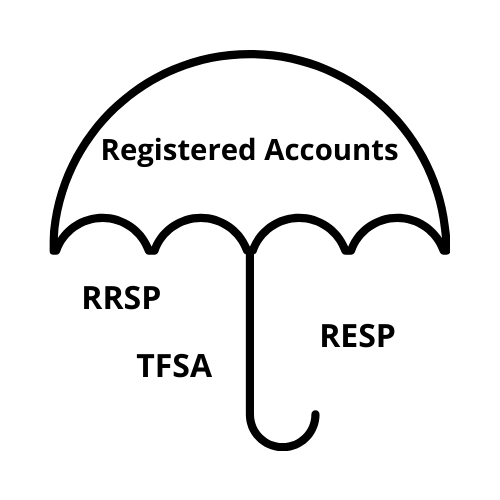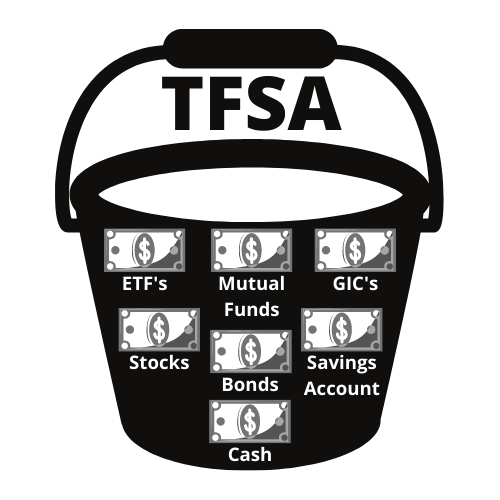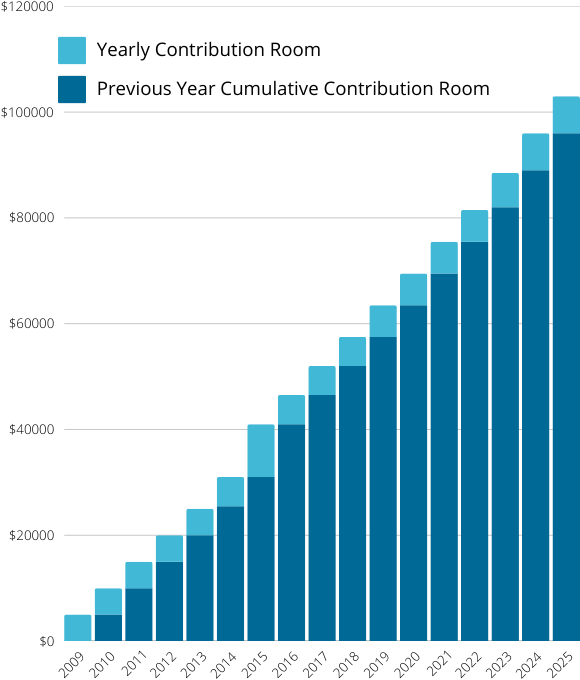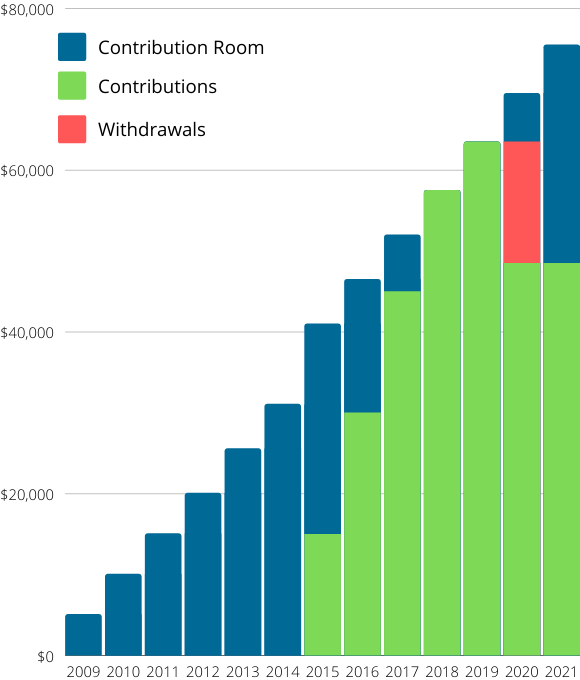Estimated reading time: 7 minutes
Updated: January 2025
The Tax-Free Savings Account
Welcome to the basics #2 – How a TFSA works.
TFSAs are a type of account that falls under the registered umbrella in Canada. This means they have special tax privileges (as in there isn’t any!) and your contributions and withdrawals are tracked by the government (CRA).
Some other examples of registered accounts are the RRSP (Registered Retirement Savings Plan) and RESP (Registered Education Savings Plan). There are others, but we’ll focus on these as they are the main accounts when you are in the wealth accumulation phase of your life.

The TFSA Bucket
Think of TFSA’s as another bucket, similar to an RRSP. They hold your funds that you want to accumulate for savings or retirement. When people say “I’m going to invest in TFSAs”, what they really mean is that they’ll be holding their money in the TFSA bucket.
There are many investments that are TFSA eligible. These include ETF’s, mutual funds, GIC’s, stocks, bonds, and cash.

Tax Treatment
- TFSA withdrawals are tax free!
- TFSA contributions do not get a tax refund as they are made with after-tax money (net income)
- U.S. securities are subject to a 15% dividend withholding tax (more on this later)†
TFSA’s are considered a tax shelter strategy. They let your investments, including interest, dividends, and capital gains grow tax free for life!
The Benefits of a TFSA
- Tax-Free Growth and Withdrawals.
The TFSA provides a great tax shelter for your investments. If your investments grow 100x, you can make as many withdrawals as you like and not have to pay any additional tax. Unlike an RRSP, which treats withdrawals as income. - Flexibility – You recover your contribution room from withdrawals.
On January 1st of every year, you earn the year’s contribution limit ($6,000 in 2021), as well as your contribution room from your previous calendar year’s withdrawals. This flexibility is great if you have an emergency and need to pull money out.
The Drawbacks of a TFSA
- Contributions do not reduce your tax burden
Unlike RRSP contributions that reduce your tax payable, TFSA do not have any tax advantage on contributions. The tax advantage is on withdrawals. - Flexibility – It’s TOO easy to pull money from
The beauty of TFSA’s flexibility is also its downfall from a behavioral finance perspective. It is very easy to pull money out of a TFSA as you just get your contribution room back next year. This leads many people to use TFSA’s a savings account instead of for long-term investing which costs you money in the long run. - U.S. Withholding Tax on Dividends†
Unlike the RRSP, TFSA’s have a 15% withholding tax applied on U.S. dividends by the IRS. This tax is removed from your returns so you wouldn’t even know it’s happening, but it is a drag on your returns. - Not a lot of contribution room for top income earners
Since the yearly contribution limits are now $6,000, for top income earners, this is not a lot of sheltered savings. They would need to invest in a non-registered account if their RRSP is also maxed. I call this a good problem to have!
NOTE: Don’t be concerned that I’ve listed more cons than pros. I was getting nitpicky with the drawbacks. The TFSAs HUGE advantage is the tax free growth and withdrawals!
What’s my Contribution Limit?
If you have been eligible since 2009 (18 years or older with a valid SIN), your cumulative contribution room in 2025 will be $102,000.
You can find out your actual TFSA contribution room by signing up for a CRA My Account. Or you can use this calculator from MoneySense to get an idea.
An interesting feature of the TFSA is that only your contributions and withdrawals affect your contribution room. Your investment gains and losses only affect the investment value.
For example, let’s say you contributed $50,000 that lost 50% of its value, and then you withdrew the $25,000. The contribution room you get next year is not $50,000, it’s $25,000. You’ve essentially lost $25,000 worth of contribution room.
The reverse is also true, if you invested $50,000 that doubled its value, and then you withdrew the $100,000. You’ve just doubled your contribution room by some savvy investment gains (note that day trading in your TFSA may get attention from the CRA).
Here is an image of the cumulative contribution room if you have never invested in your TFSA.

| Year | Annual Contribution Amount |
|---|---|
| 2009 | $5,000 |
| 2010 | $5,000 |
| 2011 | $5,000 |
| 2012 | $5,000 |
| 2013 | $5,500 |
| 2014 | $5,500 |
| 2015 | $10,000 |
| 2016 | $5,500 |
| 2017 | $5,500 |
| 2018 | $5,500 |
| 2019 | $6,000 |
| 2020 | $6,000 |
| 2021 | $6,000 |
| 2022 | $6,000 |
| 2023 | $6,500 |
| 2024 | $7,000 |
| 2025 | $7,000 |
| Total Since 2009 | $102,000 |
TFSA Contributions & Withdrawal Example
The below example shows how contributions and withdrawals affect your contribution room. This individual was eligible in 2009 but didn’t start contributing until 2015.
- Started contributing $15,000 a year in 2015
- Maxed out in 2018 ($57,500) and 2019 ($63,500)
- There was an emergency, job loss, or large purchase and they withdrew $15,000 in 2020
- In 2021 they recovered their $15,000 withdrawal
NOTE: For simplicity, this example does not take into consideration any investment gains/losses.

End result:
On January 1st, 2021, they received their $6,000 yearly contribution limit, plus recovered the $15,000 withdrawal from the previous year. There was also $6,000 of contribution room available from the previous year, totaling $27,000.
Their current TFSA value is $48,500 ($63,500 in contributions minus the $15,000 withdrawal).
| Year | Yearly Limit | Contribution Room | Contributions / Withdrawals | TFSA Value |
|---|---|---|---|---|
| 2009 | $5,000 | $5,000 | $0 | $0 |
| 2010 | $5,000 | $10,000 | $0 | $0 |
| 2011 | $5,000 | $15,000 | $0 | $0 |
| 2012 | $5,000 | $20,000 | $0 | $0 |
| 2013 | $5,500 | $25,500 | $0 | $0 |
| 2014 | $5,500 | $31,000 | $0 | $0 |
| 2015 | $10,000 | $26,000 | $15,000 | $15,000 |
| 2016 | $5,500 | $16,500 | $15,000 | $30,000 |
| 2017 | $5,500 | $12,500 | $15,000 | $45,000 |
| 2018 | $5,500 | $0 | $12,500 | $57,500 |
| 2019 | $6,000 | $0 | $6,000 | $63,500 |
| 2020 | $6,000 | $6,000 | $-15,000 | $48,500 |
| 2021 | $6,000 | $27,000 | $0 | $48,500 |
Final Thoughts
I hope that simplifies for you how TFSA’s work.
As you can see, the TFSA is a powerful retirement tool here in Canada. Combined with automated saving, you can be well on your way to financial independence.
If you are looking for ideas on how to save more, check out 10-year purchase mindset post or my savings calculator.
Please let me know your thoughts on TFSAs!
† U.S. Dividends Withholding Tax
Any U.S. dividends received within a TFSA are subject to a 15% withholding tax by the IRS. But don’t ignore U.S. equity in your TFSA. The U.S. market is the largest in the world, and being invested in broad market index funds, you have a more diversified and less volatile portfolio. Well worth the tax drag.
I would not avoid holding U.S. index funds in your TFSA simply to pay less tax. Dividends are only a part of your total return. For example, if own VUN (Total US Stock market Index), with a 2% dividend and the total return is 7%, your tax drag is 0.30% (15% of 2%). You still will get a 6.70% return.
You can see the Canadian Couch Potato’s (CCP) take on withholding taxes here: The Wrong Way to Think About Withholding Taxes.
NOTE: You should try to avoid U.S. dividend paying stocks in your TFSA (i.e. Microsoft, Walmart). Investing in non-dividend paying stocks are OK (i.e. Tesla, Google) but I still prefer broad market ETFs.
Leave a Reply